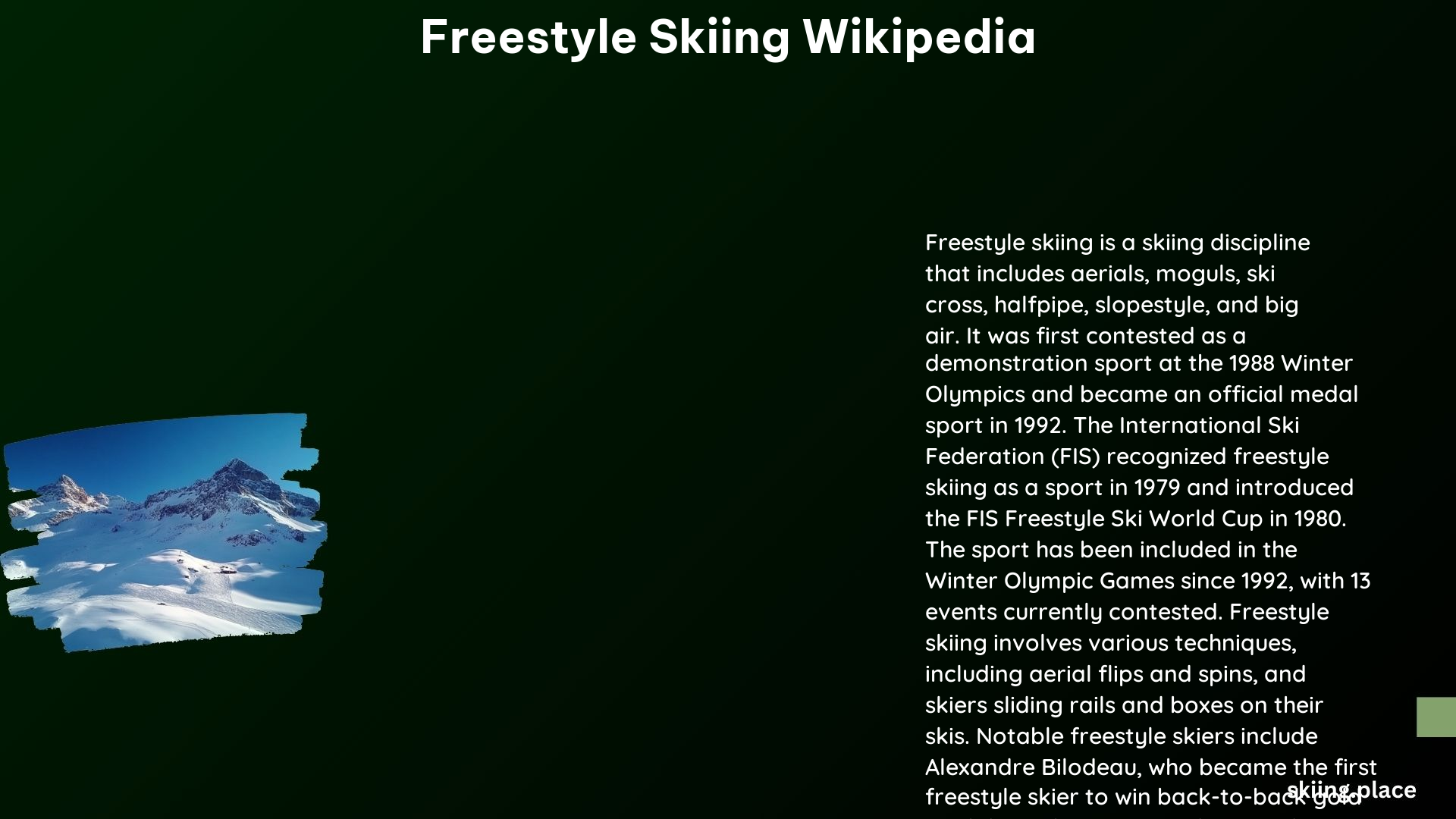Freestyle skiing is a skiing discipline that encompasses several events, each with unique characteristics and requirements. This article provides a comprehensive overview of freestyle skiing, focusing on the different disciplines, its recognition by the International Ski Federation (FIS), and its Olympic events.
What are the Disciplines of Freestyle Skiing?
Freestyle skiing includes the following disciplines:
- Aerials (AE)
- Moguls (MO)
- Ski Cross (SX)
- Halfpipe (HP)
- Slopestyle (SS)
- Big Air (BA)
Aerials (AE)
- Description: Skiers perform flips and twists off jumps, typically 2-4 meters high, and land on a 34-39 degree inclined hill.
- Unique Characteristics: Skiers are judged on jump takeoff, form in the air, and landing. The degree of difficulty (DOD) is factored into the total score.
- Rules/Scoring: Skiers are judged on a cumulative score of two jumps, with scores not carrying over to the next round.
Moguls (MO)
- Description: Skiers navigate through a series of bumps (moguls) on a steep, uneven slope, performing turns and jumps along the way.
- Unique Characteristics: Skiers are judged on their speed, technique, and ability to maintain control while navigating the course.
- Rules/Scoring: Skiers are judged on their time, turns, and jumps, with a focus on maintaining control and speed throughout the course.
Ski Cross (SX)
- Description: Skiers race down a course with jumps, banked turns, and other features, often in a head-to-head format.
- Unique Characteristics: Skiers are judged on their speed and ability to navigate the course while maintaining control.
- Rules/Scoring: Skiers are judged on their time, with the fastest skier winning.
Halfpipe (HP)
- Description: Skiers perform tricks and stunts in a halfpipe, a U-shaped course made of snow.
- Unique Characteristics: Skiers are judged on the difficulty and execution of their tricks, as well as their overall style and flow.
- Rules/Scoring: Skiers are judged on the difficulty and execution of their tricks, with a focus on style and flow.
Slopestyle (SS)
- Description: Skiers perform tricks and stunts on a course with various features such as jumps, rails, and boxes.
- Unique Characteristics: Skiers are judged on the difficulty and execution of their tricks, as well as their overall style and flow.
- Rules/Scoring: Skiers are judged on the difficulty and execution of their tricks, with a focus on style and flow.
Big Air (BA)
- Description: Skiers perform high-flying jumps and tricks off a large jump, often with complex rotations and twists.
- Unique Characteristics: Skiers are judged on the height and difficulty of their jumps, as well as their ability to land smoothly.
- Rules/Scoring: Skiers are judged on the height and difficulty of their jumps, with a focus on smooth landings.
When was Freestyle Skiing Recognized by the International Ski Federation (FIS)?

Freestyle skiing was officially recognized as a sport by the International Ski Federation (FIS) in 1979. This recognition marked a significant milestone in the development of freestyle skiing, leading to the establishment of formal rules, competitions, and Olympic events.
What are the Olympic Events in Freestyle Skiing?
The Olympic events in freestyle skiing include:
- Aerials
- Moguls
- Ski Cross
- Halfpipe
- Slopestyle
- Big Air
Aerials
- Format: Skiers perform two jumps, with scores combined for a final result.
- Scoring: Skiers are judged on jump takeoff, form in the air, and landing, with a degree of difficulty factored into the total score.
- Notable Performances: The top male aerialists can perform triple back flips with up to four or five twists.
Moguls
- Format: Skiers navigate through a series of bumps (moguls) on a steep, uneven slope, performing turns and jumps along the way.
- Scoring: Skiers are judged on their time, turns, and jumps, with a focus on maintaining control and speed throughout the course.
- Notable Performances: Mogul skiing was added as an official medal event at the 1992 Winter Olympics in Albertville.
Ski Cross
- Format: Skiers race down a course with jumps, banked turns, and other features, often in a head-to-head format.
- Scoring: Skiers are judged on their time, with the fastest skier winning.
- Notable Performances: Ski cross was added to the Olympic program at the 2010 Winter Olympics in Vancouver.
Halfpipe
- Format: Skiers perform tricks and stunts in a halfpipe, a U-shaped course made of snow.
- Scoring: Skiers are judged on the difficulty and execution of their tricks, as well as their overall style and flow.
- Notable Performances: Halfpipe skiing was added to the Olympic program at the 2014 Winter Olympics in Sochi.
Slopestyle
- Format: Skiers perform tricks and stunts on a course with various features such as jumps, rails, and boxes.
- Scoring: Skiers are judged on the difficulty and execution of their tricks, as well as their overall style and flow.
- Notable Performances: Slopestyle skiing was added to the Olympic program at the 2014 Winter Olympics in Sochi.
Big Air
- Format: Skiers perform high-flying jumps and tricks off a large jump, often with complex rotations and twists.
- Scoring: Skiers are judged on the height and difficulty of their jumps, as well as their ability to land smoothly.
- Notable Performances: Big air skiing was added to the Olympic program at the 2018 Winter Olympics in Pyeongchang.
Reference
- International Ski Federation (FIS): https://www.fis-ski.com/
- U.S. Ski & Snowboard: https://usskiandsnowboard.org/
- Wikipedia – Freestyle Skiing: https://en.wikipedia.org/wiki/Freestyle_skiing
